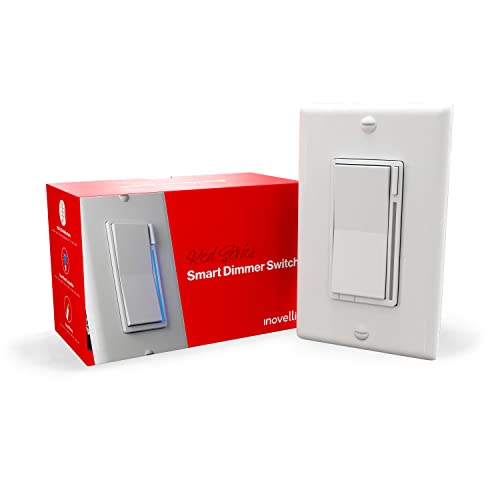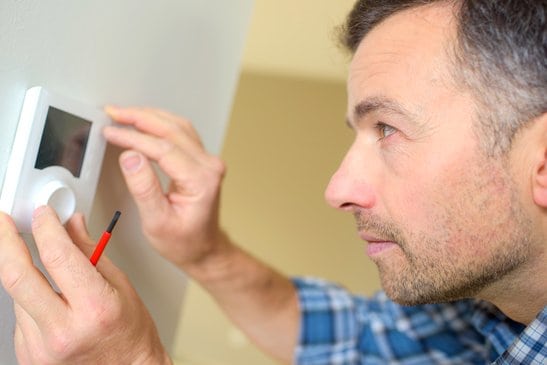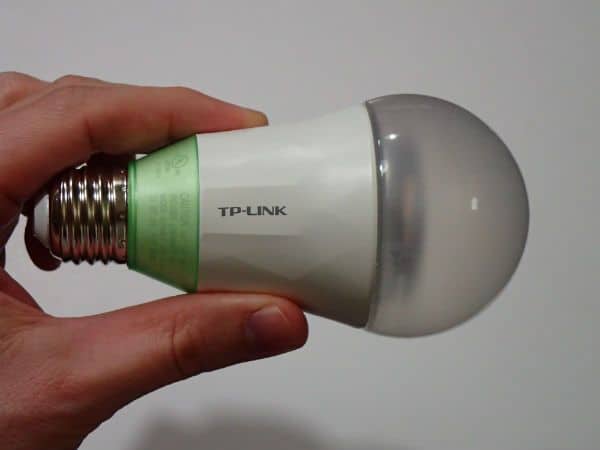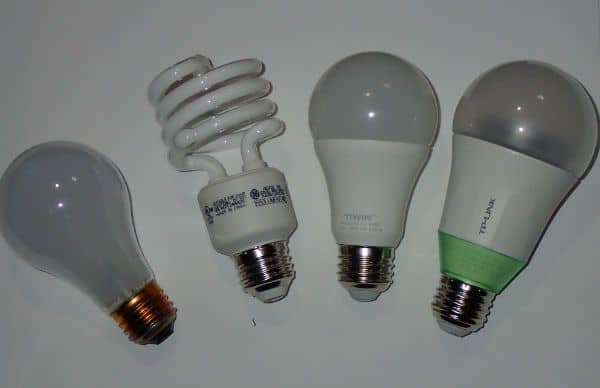Whether you’re looking for a simple on/off switch…or you want a “super-switch” decked out with all the available advanced features, I’ll take you through your options and help you find the best Z-Wave switch for your needs.
When I first started writing this article, I was a little worried that there wouldn’t be much substance to it. After all, how difficult can it be to choose a decent light switch?
It turns out, it’s not difficult to find a decent switch, but there are a TON of features that go into making a great Z-Wave switch.
Therefore, I’ll make it simple:
The best Z-Wave switches right now are the Zooz 700 series switches.
They are some of the most advanced Z-Wave switches available. They include the latest 700 series Z-Wave chip, advanced automation options, and simplified 3-way switch ability. And yet, they are still one of the lowest priced Z-Wave switches.
If you don’t care about the advanced home automation features and just want simple on/off/dimming functions, I STILL recommend the Zooz 700 series switches. There’s no harm in having the extra features. It doesn’t make installing or using the switch any more difficult. What does matter is the greater range and faster processing speed of the 700 series chip and the inexplicably low price tag on the Zooz switches.
The main reason to NOT get the Zooz switches is if your wiring requires a switch that works with “no neutral”. In that case, I recommend the Inovelli Red Series (if it’s in stock) or the more expensive HomeSeer.
The HomeSeer is arguably a better switch than the Zooz. It works with “no neutral” and has a more customizable LED notification strip. However, it costs nearly twice as much. To me, the differences are small enough, that the extra cost of the HomeSeer is not justified.
NOTE: The supply of Z Wave chips has been impacted by the global supply chain issues, and some companies are struggling to keep their switches in stock. For that reason, some of the switches on this list are out of stock.
Best Z-Wave switch: Zooz ZEN77 Dimmer Switch

Zooz has been highly regarded within home automation circles for several years. They’ve always been good, but their latest Z-Wave switches have raised the bar. The Zooz 700 series switches are equipped with all the advanced automation options, they have the latest Z-Wave hardware, and yet they are still one of the lower priced options.
To me, putting them at the top of this list is a no-brainer.
The Zooz dimmer advanced features include multi-tap scene controls, smart bulb mode, and a single LED with programmable brightness and color (for notifications).
One unique feature that I use ALL the time is Night Light Mode. If the light is off, you can press and hold the lower paddle to turn the light on to low brightness. This works wonderfully if I’m trying to move about at night without waking my wife.
Another similar feature the ZEN77 has is that you can double tap on the up paddle to immediately go to a brightness setting of your choosing.
The ZEN77 has a max load for LEDs of 100W (300W incandescent). If your lights are approaching this limit, you would want to get the ZEN72 instead. It’s still part of the 700 series, and it can handle up to 150W LED (500W incandescent). If you DON’T need the extra capacity, I would stick with the ZEN77 since it will give better all-around dimming performance. More info ZEN77 vs ZEN72
The Zooz 700 series includes the two dimmer switches I mentioned above, and a full line of other Z-Wave switch variations. They come in on/off switch, or dimmer models. Each of those is available in either paddle or toggle formats. There’s also a scene controller, an outdoor plug, and relays.
The only thing the Zooz switches are missing is the ability to work in no neutral situations. If a “no neutral” Z-Wave switch is what you need, I recommend looking at HomeSeer or Inovelli.
| Preview | Product | Price | |
|---|---|---|---|

|
Zooz 800 Series Z-Wave Long Range S2 Dimmer Switch ZEN77 800LR, White | Simple Direct 3-Way and… |
$38.95 |
Shop on Amazon |
Best Upgrade: Homeseer HS-WX300 Dimmer

The Homeseer dimmer has nearly all the features you could ask for. It’s powered by the 700 series Z-Wave chip, has a shallow depth which makes for a better fit in crowded boxes, supports multi-tap for scenes, and supports smart light control.
Also, it has a unique LED strip that is fully customizable. The switch has 7 LEDs arranged vertically next to the paddle. Each LED can be custom programmed with color, blink rate, and intensity. I personally don’t have a need or desire to get crazy with programming the LED strip. But, I know there are lots of you that love to tinker and come up with ridiculous (but occasionally useful) ways to use features like this.
One small strike against the Homeseer dimmer is that it requires an add-on switch for 3-way operation. This creates a small additional cost compared to the option of using a dumb switch (both Zooz and Inovelli work with a dumb switch).
A bigger strike (and the reason I didn’t list the Homeseer dimmer as the top Z-Wave switch) is that it’s one of the most expensive Z-Wave switches I’ve found. Both the Inovelli and Zooz switches offer close to the same feature set, but are priced significantly lower.
| Preview | Product | Price | |
|---|---|---|---|

|
HomeSeer HS-WX300 Z-Wave Plus Smart Dimmer & Switch w/RGB LED indicators, Multi-Tap Automation… |
$59.00
$54.00 |
Shop on Amazon |
Inovelli Red Series LZW31-SN

When the Inovelli Red Series switches were first released, it was the first time I had seen a Z-Wave switch with awesome advanced features such as multi-tap scene control, custom led notifications, and smart light mode. I suppose you could say I became a bit of a fan-boy (my review).
Since then, my enthusiasm for Inovelli has cooled off a bit. It doesn’t have anything to do with their product quality. I still have my Inovelli switches and they still work great. However, they have been struggling to keep their products in stock. Meanwhile other competitors (most notably Zooz) have caught up.
The Inovelli Red switches are still working with the 500 series chip, while both the Zooz and HomeSeer have upgraded to the 700 series chip. The main advantage Inovelli still has over Zooz is that it works in no neutral installs. However, HomeSeer does work with no neutral. So in that case, the only significant advantage the Inovelli switch has is a lower price.
| Preview | Product | Price | |
|---|---|---|---|

|
Inovelli ZWave Dimmer Switch (Red Series) | No Neutral Required | Energy Monitoring, Repeater, 3-Way… | Shop on Amazon |
Best Looking? Leviton Z-Wave Plus

Leviton is a mainstay in the lighting controls space. They are the original creators of the popular Decora trim style. The Decora style paired with a Leviton screwless wall plate gives the switch a super-clean look.
The dimming control on the Leviton is somewhat unique. A single up/down tap of the paddle is used for on/off control. On the right side next to the paddle is another thin button that controls dimming.
On the left side of the paddle is a vertical strip of LEDs that indicate light status. These LEDs are NOT programmable.
Other than that, it is a pretty standard Z-Wave dimmer switch. It requires a neutral, uses an add-on for 3-way switching, and doesn’t support any of the geeky advanced features.
| Preview | Product | Price | |
|---|---|---|---|

|
Leviton DZMX1-1LZ Decora Z-Wave Controls Universal Dimmer, White/Ivory/Light Almond |
$56.00 |
Shop on Amazon |
Best Marketing: GE Enbrighten Dimmer (Model#46203)

Yeah, I said it – Best Marketing…
Translation: They’ve managed to sell a ton of average switches at premium prices. Bravo!
Everything about the Enbrighten switches seems designed to make them EASY to install and use, which is great for selling to the masses.
First off, the switch is small. The shallow depth (1.13″) makes it easy to install in shallow electrical boxes and still have room to stuff the wiring in behind. Also, the metal tabs have been trimmed off the sides, which makes it easy to stack several switches side by side in a multi-gang electrical box.
Connecting the wires is easy, too. With their SimpleWire technology, you can plug the line and load wires into either hole, and the switch will sense which wire is which (with other models, incorrect wiring would destroy your switch).
Finally, the switch includes the Z-Wave SmartStart feature, which allows you to include your switch to your Z-Wave network by simply scanning a QR code.
All these features should make for a quick and painless installation, right?
Yes, of course!
So why am I hating on the GE Enbrighten stuff?
- ALL the other top Z-Wave switches have the easy to install features, too (except for SimpleWire).
- The Enbrighten switches don’t come with any of the advanced automation features that the other top Z-Wave switches have.
- They are typically one of the highest priced Z-Wave switches.
You could buy a Zooz switch and get the same easy installation at a lower price, AND get the full suite of extra home automation features, AND get the latest 700 series Z-Wave chip.
But hey, what do I know!?
If you don’t see yourself needing any advanced features, and you don’t mind paying a little extra to get a brand name that you’re familiar with, then the Enbrighten line of Z-Wave switches will work just fine for you.
Also, if you are leaning in this direction, take a look at the UltraPro brand switches.The Enbrighten switches are manufactured by Jasco which also manufactures the UltraPro switches. As far as I can tell, the two switches look and function the same. So, if you’re looking to be frugal, you should be able to compare prices (see below) between the two and choose the cheapest.
Deciding Factors
If I scoured the internet, I could easily find 20 different brands that make Z-Wave switches. Nearly all of them have a core set of features that are basically the same. Nobody cares about that stuff. What you really want to know about are the differences between them. Using my research and personal experience, what follows are the features of Z-Wave switches that I think make a difference.
Z Wave Plus
At this point, any Z-Wave device you buy should be Z-Wave Plus. It provides faster communication and better range than the previous generation of Z-Wave chips.
When it was first created, the Z-Wave Plus certification included devices that had the 500 series Z-Wave chip, which improved range and speed from previous chips. Since then, the new 700 series Z-Wave chip has been released. Now, both the 500 series and 700 series are considered Z-Wave Plus. The 700 series chip boasts even better range and speed than the 500 series.
Currently, Zooz and Homeseer have switches with the 700 series chip. However, multiple manufacturers are working to release new switches with the 700 series hardware.
Smart light control
This is an optional feature that allows you to use the switch with a smart bulb without ever cutting power to the smart bulb.
For example, if you press the off button on the switch, it won’t cut the power to the fixture. Instead, it will send a Z-Wave command that tells the light to shut itself off.
Zooz, Inovelli, and Homeseer have switches equipped with this feature. However, only some hubs support the feature.
Why would you want to use a smart bulb AND a smart switch on the same circuit? Using both allows you to have the awesome color-changing effect of smart bulbs, and still retain the convenience of a wall mounted switch.
Scene Control
Some Z-Wave switches allow you to double tap (or triple tap, etc.) your switch to trigger additional scenes or routines. The extra scenes can control lighting, but they don’t have to. You can setup a routine to control anything you can control with your Z-Wave hub.
Zooz, Inovelli, Homeseer switches support advanced scene control. However, only some hubs support the feature.
LED Notification Strip
A couple of these switches have thin strips of LED lights integrated into the body of the switch. Under normal circumstances, these lights simply indicate the power status of the switch. However, with a little extra programming using the Z-Wave protocol, they can be used to display color-coded notifications.
Most of the switches at least have an LED that indicates on/off status. But, only Zooz, Inovelli, and Homeseer have LEDs that can be custom programmed for notification purposes.
Works with no neutral wiring
Most smart switches require a neutral wire in the switch box in order to power the switch. However, the wiring in some older homes doesn’t include neutral wires in every switch box. Therefore, in order to replace your old switch with a smart switch, you need a smart switch with special circuity that allows it to work with no neutral.
The Z-Wave switches that work with no neutral are Inovelli and Homeseer.
NOTE: If you have no idea what a neutral wire is, I explain it in more detail here. Most homes built after the mid-80’s will have the required wiring to power any smart switch.
3-way switching
A 3-way switch is when two switches are connected to the same load (light fixture). You can flip either switch to toggle the light on or off. All of the Z-Wave switches listed here work with 3-way switches, they just differ in how they make it work.
There are 3 typical methods used by smart switches for 3-way switches:
- Dumb switch (simple, low-cost) – One switch is replaced with the smart switch, and the other “dumb” switch is left in place. The light can be switched on/off and dimmed from the smart switch, but can only be switched on/off from the dumb switch (no dimming).
- Add-on switch (most common) – One switch is replaced with the smart switch, and the other is replaced with a special “Add-on” switch. The light can be switched on/off and dimmed from either the smart switch or the add-on switch.
- Smart (most expensive) – Replace both switches with smart switches. Full control from either switch.
FAQs
Final Thoughts
For most people, I recommend the Zooz 700 series switches. They are equipped with the latest hardware and the latest advanced automation options. Dollar for dollar, they are easily the best Z-Wave switches currently available. If you don’t mind spending more, the HomeSeer switches are a little more versatile since they work with no neutral and can handle a little more load. They also have the additional programmable LED lights to play with.
Lastly, if all you need is a simple switch and you want it as cheaply as possible, take a look at the UltraPro brand.









Great article. One thing I would comment about the Zooz switches, is they are primarily geared towards overhead lighting. They specifically state that they should not be used for outlets, as they aren’t rated for 15A. My home consists of mostly Ge/Jasco/Enbrighten (whatever they call themselves this week), and I have several switched outlets that I’m using GE/Jasco on/off switches to manage, and I’ve had zero problems. I haven’t tried with Zooz in these situations, but I’ve never read anything to that effect in the GE documentation. The newest GE Enbrighten switches are also slightly shallower than the Zooz switches, and all of theirs are 3 way ready, whereas Zooz makes them separate devices.
Now, I will say that their recent price hike makes the Enbrighten less appealing. They are also now harder to find, as Lowe’s no longer keeps them in stock in their stores. Their newest model (55258/ZW4008) came out in 2020, so I’m hoping they’ll start releasing a 700 series model soon to at least justify the price increase.
All that being said, I have around GE/Jasco switches in my home that are 300 series, which I am looking to replace. So long as they aren’t controlling switched outlets, I have no problem using Zooz switches to replace them.
Thanks for taking the time to share your experience! I believe the Enbrighten switches are rated for around 600W (~5 amps), but that’s for a resistive load such as lights. If you plug in something with a motor the capacity becomes less. Either way, it’s a good point that you probably shouldn’t be trying to run something like a vacuum cleaner on a switched outlet that’s controlled by one of these smart switches.
I think its worth noting in review/comparison, what color choices are available and how its achieved. The GE and Legit on I already know have swappable faces and at least the top 4 colors available, but I’d like to know what others have. I’m sticking to Light Almond in my house, but as long as you’re changing stuff out some people might like something more exotic.
Thanks for the feedback. I agree that color is important. However, it’s hard to include every important feature without making an article that is just way too long. I want to create some massive tables for articles like this that include all that extra info and make it easily sortable for the user.
I have a combination of Zooz and Ultra Pro switches in my home. I agree the Zooz switches are my usual go-to, however I do have a few gripes. Zooz doesn’t make and ivory colored paddle for their switches. They have white, light almond, black and brown. I mean really, they have brown (something I have never seen in a house) but not ivory? Seems crazy to me. Also the Zooz can’t handle motor loads, so you can’t use them with a bathroom fan. The only switch Zooz makes that can handle motor loads is their double switch designed for ceiling fan / light combos. This isn’t really practical for a basic bath fan as you end up with a light button that does nothing. The Ultra Pro switches can handle motor loads, so I use them for that purpose. The best feature with the Zooz switches is their ability to work with a standard dumb switch in a 3-way configuration. Zooz simply has the best value out there.